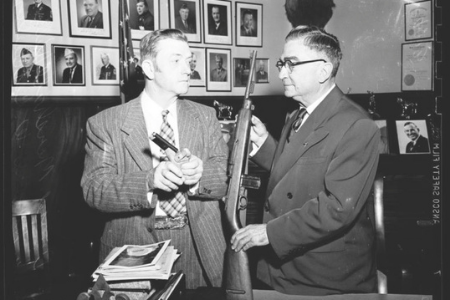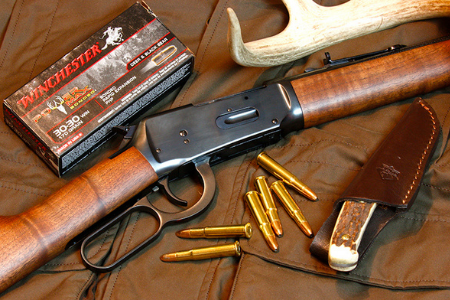Back in the late 70s, the allure of the 1911 and revolver style handguns was beginning to wane. Newer technologies around plastics, polymers and manufacturing were making high quality semi-automatics popular and affordable. Thus, in 1982 we saw the introduction of the Glock 17, and the mid-80s we saw the introduction of the Ruger “P” series, Beretta 92F and the Sig Sauer P226.

So a thought was put forth by John Risdall and Jim Skildam, the founders of Magnum Research, based in Minnesota, to attract the big bore hunting crowd and the semi-automatic pistol crowd, and built a handgun called the “L96”, chambered in .357 Magnum. Eventually, they introduced the concept of interchangeable barrels, chambered in .41 Magnum, .44 Magnum and then in 1991, the .50 Action Express, which at the time was the largest pistol caliber. Eventually the .50 AE was superseded by the .500 S&W.
But like many startups, they had the vision, just not the capital or the capacity. They were not able to mass produce the demand for this gun, so Israeli Military Industries was subcontracted to manufactured the handguns. Because of this subcontracting arrangement, many folks thought this gun was an Israeli invention. It was not. Magnum Research continued to hold the licensing rights. However, this led to the name change to “Desert Eagle”, which allowed sales to take off. IMI continued to produce the gun until 1995, when production moved to Saco, Maine.
The Desert Eagle is an amalgamation of other handgun styles. The beaver tail and magazine release model the 1911. The gas and piston system model the Ruger Mini-14, and the external safety and take down lever model the Beretta 92F. The real difference however, was in the gas operation. Typically, normal semi-automatic handguns use a “blow back” method of gas operation, whereby the expanding gasses of the fired cartridge would blow the breech backwards, thereby ejecting the spent round and chambering the next round.

But because the Desert Eagle was chambered for very large caliber pistol rounds, the gas operations had to be something different, or it would be difficult for the shooter to deal with the recoil. So the designers used a rotating bolt system, identical in function to the gas operations of an AR-15. After a round is fired, the bolt head will rotate as it moves backwards. Rotating bolt heads have very little recoil compared to their blow-back cousins. As a point of reference, my wife is skittish about shooting my 9mm, but loves shooting my AR-15 because there is hardly any felt recoil.

So in order to change out the caliber, the shooter simply has to remove the barrel and bolt head, and insert the new barrel and bolt head. The slide and the action remain untouched. So, if the shooter is in possession of the other caliber barrels and bolt head, they could theoretically shoot a .357 Magnum, .41 Magnum, .44 Magnum and the .50 AE all in one visit to the range.
The Desert Eagle has found notoriety in over 500 movies, but really found its niche in video games. As a result, the gun got its nickname, the “Deagle”, a shortcut of typing “Desert Eagle” on a keyboard. One of the first games to really take advantage of the handgun is the game Counter-Strike from Source. Players are allowed to purchase it, as it has the hardest hitting effects of any handgun in the game, so players routinely “buy” it at the beginning of the game and use it as their primary weapon throughout the game.

The company was bought out by Kahr Arms in 2010, and control of production remains with this company. Magnum Research is still very much alive in showcasing the pistol and announcing various modifications and enhancements. A look on the current offers will show over 40 different combinations to choose from, including a titanium and gold finished variant. There are even calibers smaller than .357 Magnum produced. Those calibers smaller than the .357 are commonly called “Baby Desert Eagles”, and those calibers use the standard blow back gas operating design.
This gun does have some downsides. First, it is expensive. Typical models are in the $2500 range. Second, it is not a concealed carry gun. The standard barrel is 6″ long, with an optional 10″ barrel available. Third, it is heavy, with it coming in at over 4 pounds. Fifth, while the rotating bolt gas system is great on reducing recoil, it is complicated. Sixth, specialized availability. Although I would love to sell these in the Dakota Firearms online store, we don’t because our distributors don’t carry them.
Nonetheless, this gun is selling like hotcakes. Why? Simply put, it is the allure, plain and simple. It’s pretty much the only relevant handgun chambered in .50 Action Express, and holds more rounds than similarly chambered handguns. It is a gun designed more for the “my dick is bigger than your dick” crowd, because this is the gun which will stop a bad guy hiding behind the refrigerator…at your neighbor’s house.



